Skopje is the capital of North Macedonia. The largest city in North Macedonia, Skopje, population and area-wise, serves as the country’s political, economic, academic, and cultural center.
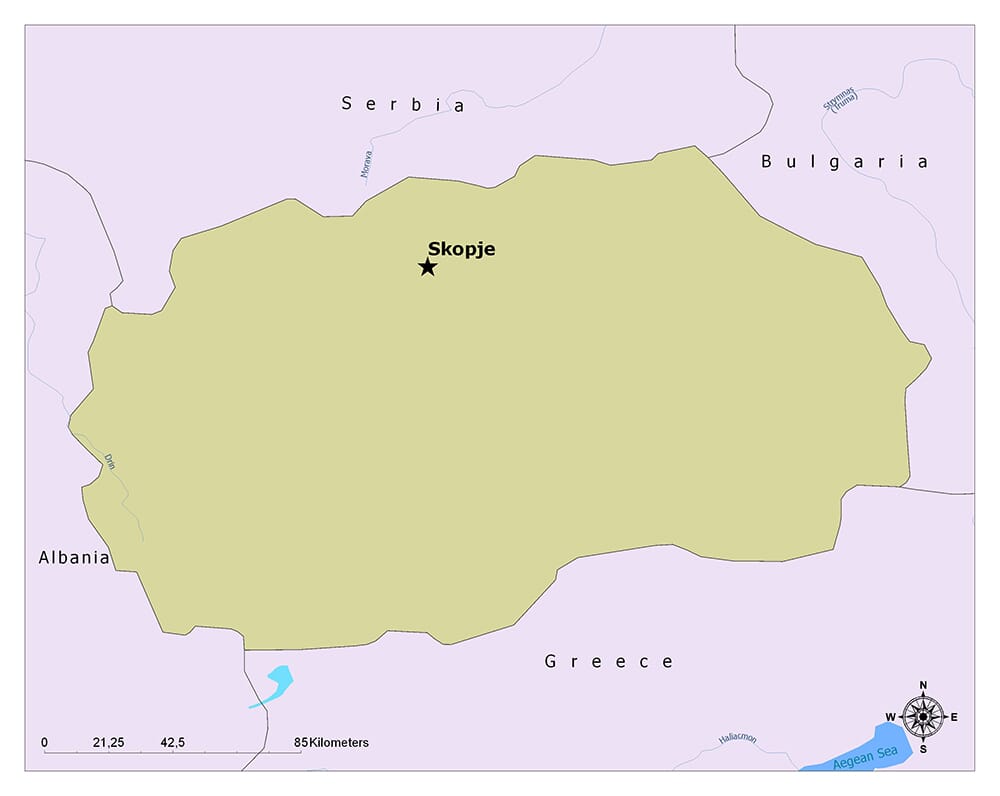
Skopje has a rich history dating back to the Roman era, and many remnants from various periods, including Roman, Byzantine, Ottoman, and Yugoslav, can be found across the city. The cityscape is a mix of architectural styles, a testament to its varied history.
Where is Skopje?
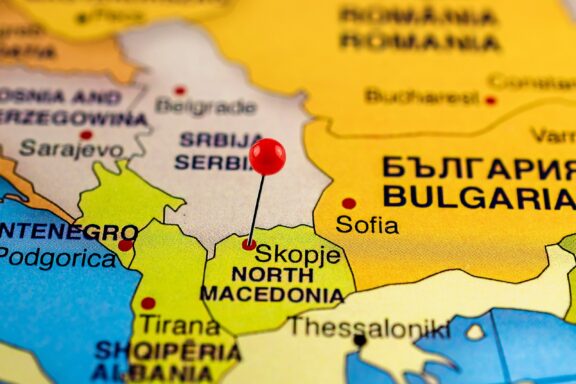
Skopje is located in the northern part of North Macedonia, in the Balkan Peninsula in southeastern Europe. The city lies on the upper course of the Vardar River and is approximately in the center of the Balkans.
Skopje is about halfway between Belgrade, Serbia, to the north, and Athens, Greece, to the south. It’s also roughly equidistant from Sofia, Bulgaria, to the east, and Tirana, Albania, to the west.
Its geographical coordinates are approximately 42.0 °N latitude and 21.4 °E longitude.
History of Skopje
Skopje has a rich history that spans thousands of years and multiple civilizations, each leaving its unique mark on the city.
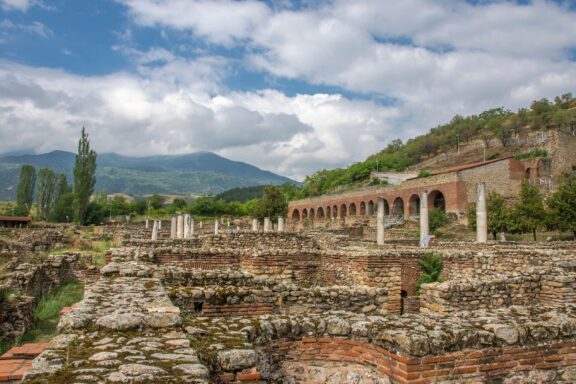
Skopje has been inhabited since 4000 BC, founded by the Illyrian tribe, Dardanians, around 3rd century BC. It fell under Philip II’s Macedonian Empire, setting a Hellenistic influence. Post Alexander the Great’s death, Skopje became part of the Roman Empire in 2nd century BC, thriving as Scupi, a key military camp and administrative center in Moesia, later damaged by an earthquake in the late 5th century.
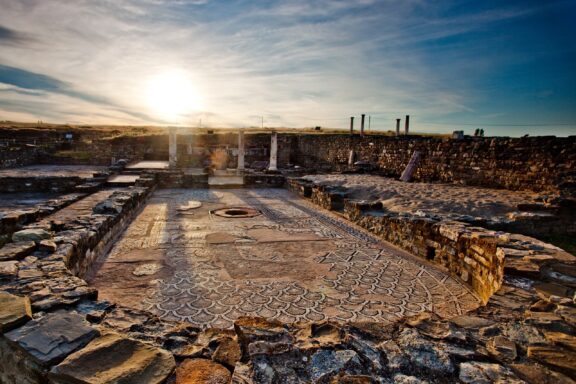
Post the Western Roman Empire’s fall, Skopje came under Byzantine and Bulgarian rule, alternating between growth and decline. It flourished as Tsar Samuil’s capital in the 10th century, with significant constructions like Samuel’s Fortress.
Despite changing hands between Byzantine and Bulgarian Empires, Skopje thrived as a trading, handicraft center, and hub for Slavic literature. In the 13th century, it became part of the Serbian Empire under Stefan Dušan.
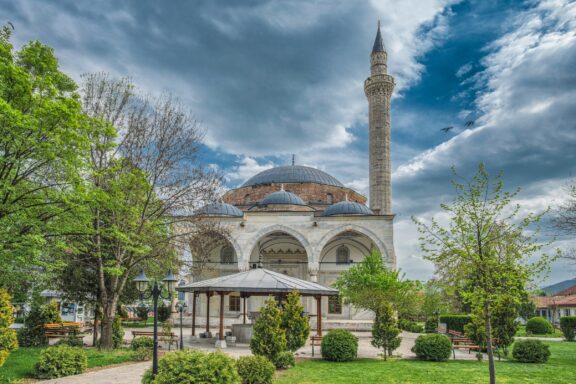
Skopje’s character was shaped through periods of control, construction, and destruction. It fell under Ottoman rule in 1392 for five centuries, growing strategically and culturally, with structures like Stone Bridge and the Old Bazaar built. Skopje changed hands multiple times in the 20th century wars, eventually becoming the capital of the Socialist Republic of Macedonia in post-World War II Yugoslavia.
In 1963 a devastating earthquake struck Skopje, destroying about 80% of the city and leaving over 200,000 people homeless. The reconstruction effort, known as “Skopje 1963”, involved international aid and architects and gave the city its modernist look.
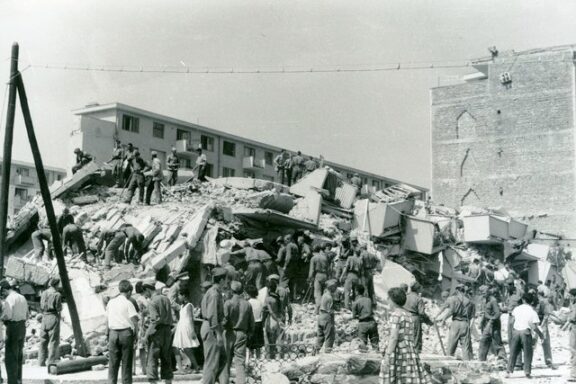
With the breakup of Yugoslavia in the 1990s, Skopje became the capital of the newly independent Republic of Macedonia (now North Macedonia). The city experienced significant development and modernization, especially during the “Skopje 2014” project, which aimed at revamping the city with new buildings, statues, and bridges in a neoclassical style. It sparked a fair amount of controversy for its cost and aesthetics.
Today, Skopje is a vibrant city that blends the ancient and modern. It is the political, economic, and cultural hub of North Macedonia, hosting numerous festivals and events. It is home to various ethnicities and religions, adding to its multicultural charm.
Features of Skopje
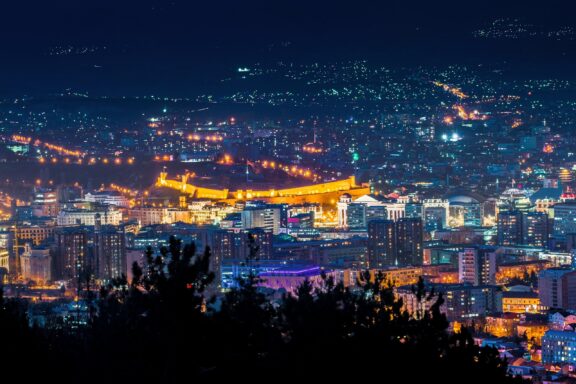
Skopje is a city with a rich past and a vibrant present, and it’s home to many significant historical landmarks, a testament to its varied history.
The city’s architecture is a mix of styles reflecting its history – Ottoman-era buildings, Brutalist structures from the post-earthquake reconstruction, and recent neoclassical and baroque-style buildings from the controversial “Skopje 2014” project.
Geography and Climate
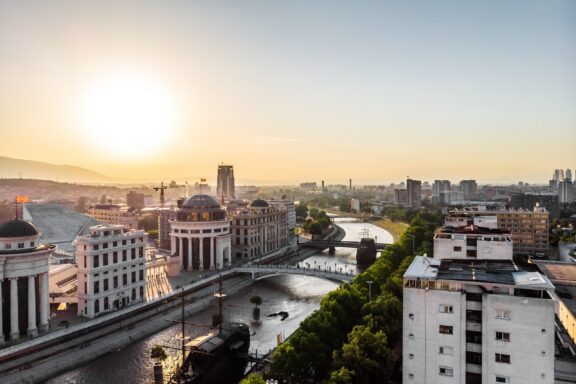
Skopje is situated in the Skopje Valley and is surrounded by several mountain ranges, including the Skopska Crna Gora range to the north, and the Vodno and Suva Gora ranges to the south. The city is approximately 240 meters (790 feet) above sea level.
The Vardar River largely defines the city’s geography, which bisects Skopje from west to east before continuing southward toward Greece. Around the city, one can find several canyons and natural and artificial lakes.
Skopje has a humid subtropical climate (Köppen climate classification Cfa), characterized by four seasons. Summers are hot and dry, often exceeding 30 °C (86 °F). Winters, by contrast, can be quite cold, with temperatures often dropping below freezing and occasional snowfall. Spring and fall shoulder seasons are mild, with moderate temperatures and more precipitation compared to the summer months.
Population
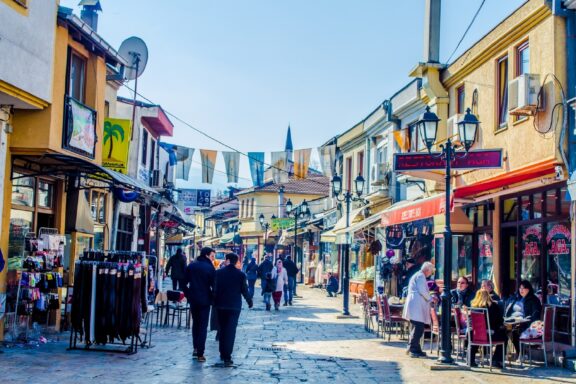
Skopje had a population of over half a million residents. Skopje is a diverse city in terms of ethnicity and religion. Most residents are ethnic Macedonians, followed by significant communities of Albanians, Turks, Romani, Serbs, Bosniaks, and others. The city is predominantly Orthodox Christian, but there is also a substantial Muslim community and smaller groups of other religious affiliations.
The city’s residents are known for their warm hospitality. Skopje has a vibrant culture and lifestyle, with various festivals, markets, and public events throughout the year.
Economy
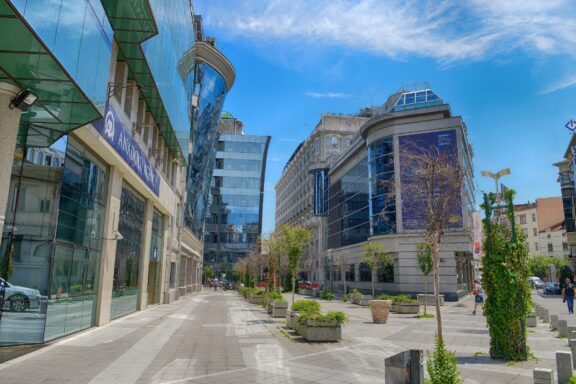
Skopje is the economic heart of North Macedonia and has a diverse economy. The city is a major center for metal-processing, chemical, timber, textile, leather, and printing industries. Food processing and trade also represent significant sectors.
The city is a regional transport hub, hosting the country’s largest railway junction and international airport. This facilitates commerce and industry in Skopje and connects the city with other parts of Europe and the world.
Skopje has also seen growth in the service sector, particularly in finance, real estate, communications, and information technology services. Many national and international companies have headquarters or regional offices in the city.
The city also has several large shopping centers, contributing to retail trade and services. The city’s rich history and cultural offerings make tourism increasingly important in the local economy.
In general, the economy of Skopje is an important component of the national economy and plays a vital role in the economic well-being of North Macedonia.
Things to Do and Places to See in Skopje
Skopje offers an abundance of activities and sights to explore. Here are some of the capital city’s most sought-after spots and attractions.
1. Old Bazaar
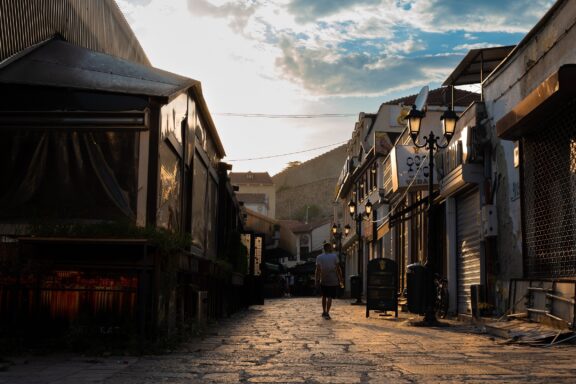
The Old Bazaar in Skopje is a fascinating place full of history, charm, and activity. One of the oldest and largest bazaars in the Balkans, it harks back to when Skopje was a major center during Ottoman rule. As you stroll through the maze-like streets, you’ll pass shops selling all kinds of goods, from traditional handicrafts and antiques to spices and textiles.
The Old Bazaar also has several historic buildings, including mosques, caravanserais, and hammams, reflecting the area’s rich cultural heritage. Interspersed among the historic sites are modern boutiques, art galleries, tea shops, and restaurants serving delicious local cuisine, creating a captivating blend of old and new.
2. Skopje Fortress (Kale Fortress)
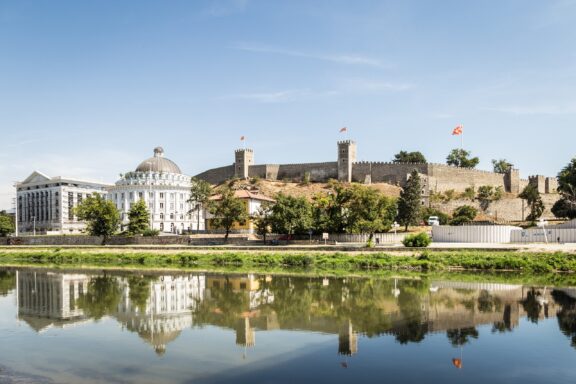
Perched atop a hill overlooking Skopje, the Kale Fortress is a monument to the city’s long history. The fortress was built in the 6th century during the reign of Byzantine Emperor Justinian I, with further expansions and fortifications added over the centuries.
Today, visitors can walk along the ancient walls, explore the ruins, and enjoy panoramic views of Skopje below. The fortress grounds are peaceful, with grassy areas and trees providing shade, making it a lovely place for a picnic with a view. The fortress also serves as a venue for cultural events and yearly performances.
3. Vodno Mountain
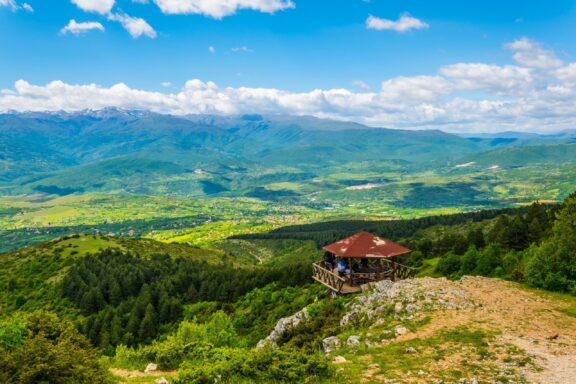
Just a few kilometers from Skopje’s city center, Vodno Mountain offers a natural escape and a wealth of outdoor activities. You can hike along the various trails, spot local flora and fauna, or take a relaxing cable car ride to the top. The mountain’s peak is home to the Millennium Cross, one of the tallest crosses in the world, standing at 66 meters high.
The cross is a popular landmark seen from all parts of Skopje. At the top of Vodno Mountain, you’re rewarded with breathtaking views of Skopje and the surrounding countryside. There’s also a restaurant near the top where you can rest and grab a bite.
4. Matka Canyon
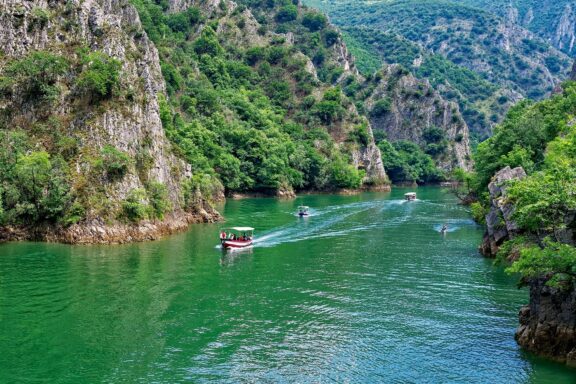
Located about 15 kilometers southwest of Skopje, Matka Canyon is a stunning natural oasis. This beautiful area is a paradise for nature lovers, offering hiking, rock climbing, kayaking, and boating activities.
The canyon is home to several medieval monasteries, including the Monastery of the Holy Mother of God, built in the 14th century, that are tucked away in the rocks and many caves. The most famous of these is Vrelo Cave, one of the deepest underwater caves in the world.
A boat trip along the Treska River, which runs through the canyon, offers the chance to take in the area’s dramatic cliffs and verdant vegetation.
5. Explore the area around the Triumphal Gate
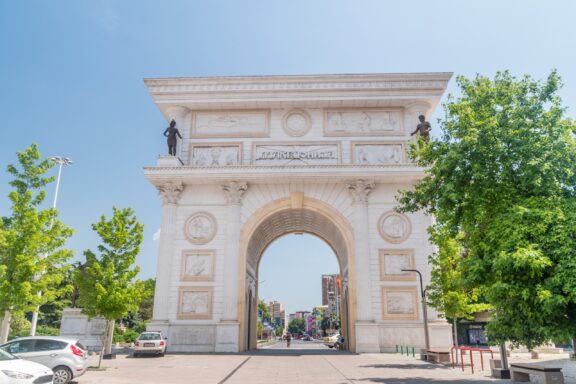
The Triumphal Gate, also known as Porta Macedonia, is in Pella Square. The square is named after the ancient city of Pella, the capital of the Kingdom of Macedon and the birthplace of Alexander the Great.
The Triumphal Gate is a significant landmark in Skopje, the capital city of North Macedonia. It was built in 2012 in the Skopje 2014 project to boost national pride and tourism but was criticized for its cost and historical revisionism.
The Arc de Triomphe inspired me in Paris; the Triumphal Gate stands 21 meters tall in Macedonia Square, Skopje’s main square. The gate’s exterior is adorned with reliefs carved by Macedonian artists, depicting scenes from Macedonian history and culture.
Inside the Triumphal Gate is a small museum, and an elevator takes visitors to the top, where a viewing platform provides panoramic views of Skopje. It’s a popular spot for tourists as well as locals.
6. Stroll the area around Stone Bridge
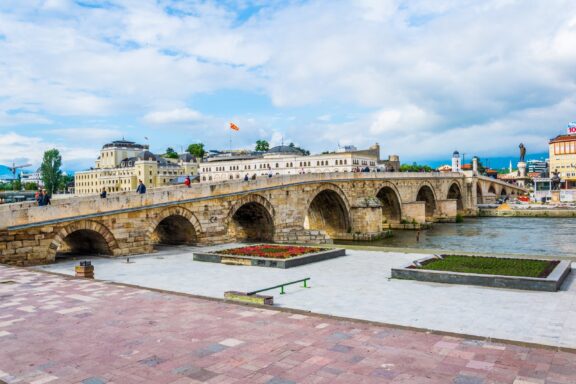
The Stone Bridge is one of Skopje’s most iconic landmarks, connecting the Old Bazaar on the eastern bank of the Vardar River with Macedonia Square and the modern city center on the western bank. Walking around this area provides a tangible sense of the city’s history and present and diverse cultural influences.
Besides the bridge itself, this part of Skopje offers several points of interest, including the statue of Alexander the Great in Macedonia Square, the Archaeological Museum of Macedonia, and the beautiful buildings of the “Skopje 2014” project.
7. St. Panteleimon Church in Gorno Nerezi
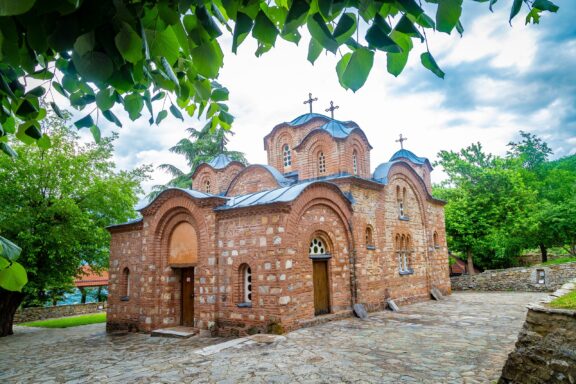
On the slopes of Vodno Mountain lies the Church of St. Panteleimon in the village of Gorno Nerezi. Built in the 12th century, this small Byzantine church is famous for its frescoes, considered masterpieces of 12th-century Byzantine painting.
The most famous fresco depicts the Virgin Mary with baby Jesus, flanked by angels, and is admired for its emotional expressiveness and the delicate representation of faces. The church is nestled in a peaceful natural setting, and the courtyard offers a stunning view of Skopje.
8. Skopje Zoo
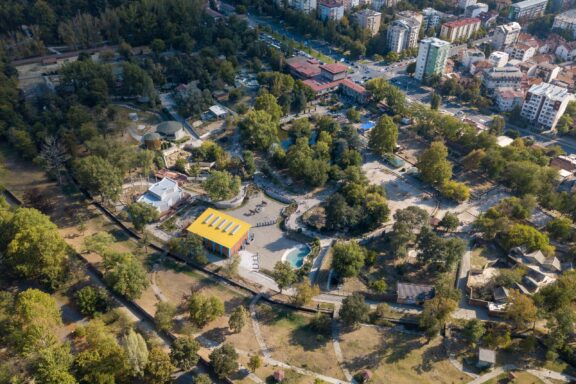
The Skopje Zoo is located in Gradski Park. The Skopje Zoo covers an area of about 12 hectares. It houses around 500 animals representing nearly 85 species, including mammals, birds, and reptiles. Some notable animals include lions, tigers, zebras, and elephants.
he Skopje Zoo was established in 1926, making it one of the oldest zoological gardens in the Balkans. Over the years, the zoo has significantly improved its infrastructure and animal welfare standards. The Skopje Zoo plays an important educational role by raising awareness about wildlife conservation. It organizes various educational programs and events for children and adults alike.
9. Memorial House Mother Theresa
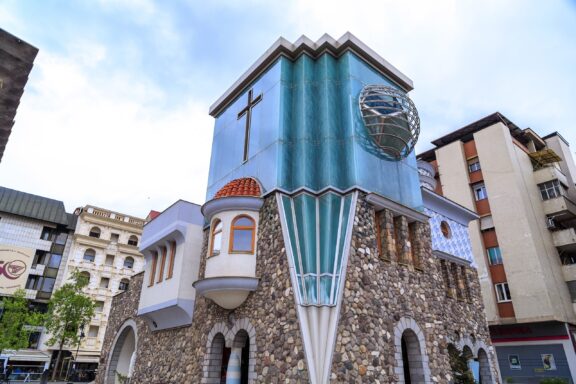
Mother Teresa, the Nobel Peace Prize-winning humanitarian, was born in Skopje in 1910. The Memorial House of Mother Teresa is dedicated to her life and work, showcasing photographs, personal items, and information about her humanitarian efforts around the world.
The house is designed to resemble her original childhood home and includes a small chapel on the upper floor. The museum offers a peaceful and inspiring insight into the life of one of the most important figures of the 20th century.
10. Macedonia Square
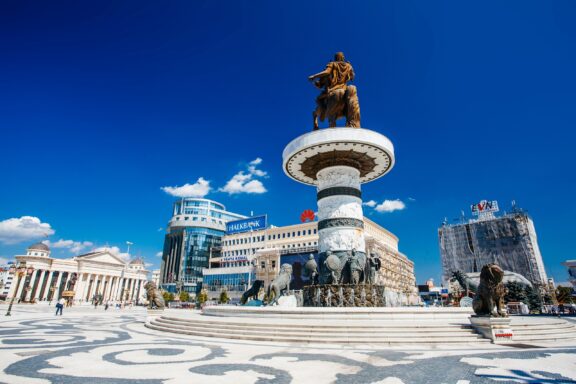
Macedonia Square is the main square in Skopje and is the heart of the city. It’s surrounded by several important buildings and landmarks, including the statue of Alexander the Great, which is set in the middle of a large fountain, and several neoclassical buildings from the “Skopje 2014” project.
The square is a popular meeting point and venue for various events and celebrations. Around the square, you’ll find numerous shops, cafes, and restaurants, making it a great place to relax and people-watch.
11. Skopje City Park
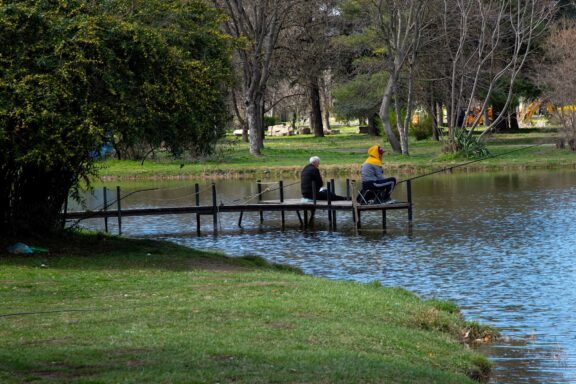
Skopje City Park is the largest and most beautiful park in Skopje. It offers walking paths, sports fields, a small zoo, and a large lake with paddle boats. The park is home to several species of trees, some over 100 years old, providing shade and tranquility.
It’s a great place for a picnic, a leisurely walk, or relaxing and enjoying the outdoors. The park also hosts various events throughout the year, including concerts and exhibitions.
12. Archaeological Museum of Macedonia
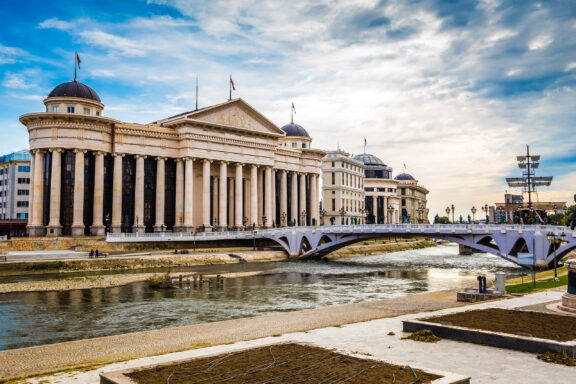
The Archaeological Museum of Macedonia is a fascinating institution in the capital city of Skopje, North Macedonia. This museum is one of the country’s most important cultural institutions and has an extensive collection of artifacts from Macedonia’s rich archaeological and historical heritage.
The museum is organized into sections highlighting aspects of Macedonian history and archaeology. These include prehistoric artifacts, items from the classical period, the Roman era, the Byzantine period, etc.
The museum houses thousands of items, including sculptures, jewelry, ceramics, and many other artifacts excavated from various archaeological sites across the country. Among these, the golden burial masks and the terracotta icons from Vinica are particularly noteworthy.
13. Adventure Park Skopje
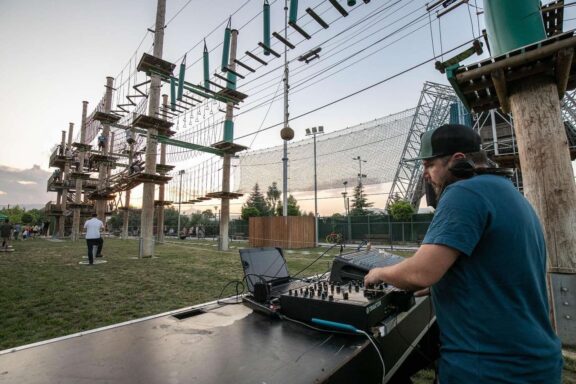
Adventure Park Skopje is an excellent choice for adrenaline enthusiasts and nature lovers. The park offers a variety of outdoor activities that can get your heart racing while allowing you to enjoy the surrounding natural beauty. The park features obstacle courses high up in the trees, with different difficulty levels catering to children and adults.
The courses include a mix of rope swings, bridges, climbing nets, and zip lines. It’s an exhilarating way to challenge yourself physically while having fun. After the adventure, you can relax in the park’s café area. The park staff are trained to ensure safety, so you’ll be in good hands even if you’re new to this adventure.
14. Macedonian Holocaust Museum
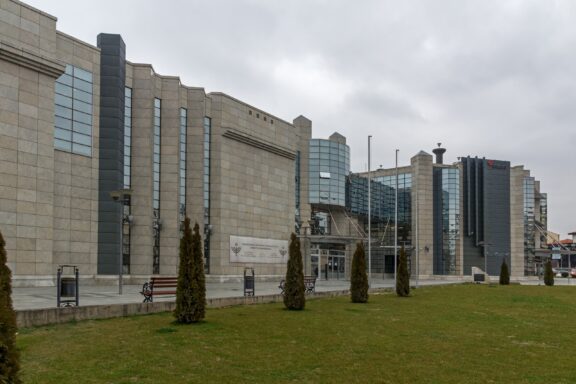
The Holocaust Memorial Center for the Jews of Macedonia is a poignant museum dedicated to the history of the Jews in Macedonia and the Holocaust. Through multimedia exhibits, personal stories, and historical documents, the museum educates visitors about the vibrant Jewish community that once existed in Macedonia and the tragic events of World War II. The museum is a solemn and important reminder of the past, promoting understanding and tolerance.
15. Skopje Aqueduct
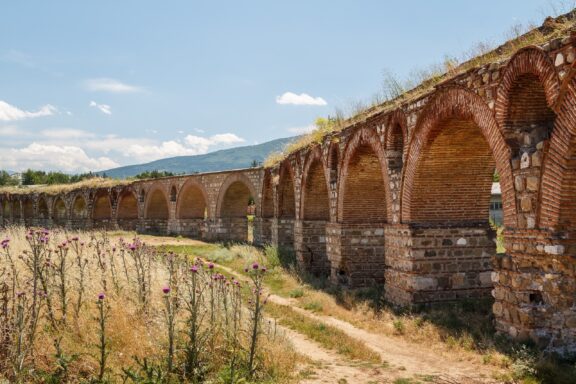
Located in the village of Vizbegovo just outside of Skopje, the Skopje Aqueduct is an intriguing historical site. The aqueduct is the only one in North Macedonia and one of three well-preserved in the former Yugoslavia.
The exact date of its construction is still being determined, with theories suggesting it was built in the Roman, Byzantine, or Ottoman periods. The aqueduct has 55 arches and extends for more than 386 meters (1,266 feet). It’s a fascinating place to explore and offers a glimpse into the historical ingenuity of the area.
Frequently Asked Questions
What currency is used in North Macedonia?
The official currency of North Macedonia is the Macedonian denar (MKD).
What is the best time to visit Skopje?
The best time to visit Skopje is during the spring (April to June) and fall (September and October) when the weather is mild and the city is less crowded.
What is the traditional food and cuisine scene like in Skopje?
Macedonian cuisine is rich, hearty, and influenced by Mediterranean and Middle Eastern cultures. It features a lot of meat and vegetables, with a particular emphasis on grilling and baking. Here are some of the dishes that are commonly enjoyed in North Macedonia:
• Tavche Gravche: Often considered the national dish of North Macedonia, Tavče Gravče is a comforting dish made from beans, paprika, and other ingredients, which are then baked in a traditional clay pot. The beans are typically served with sausage or pork.
• Ajvar: This relish is made primarily from red bell peppers with garlic, eggplant, and chili peppers. It can be mild or hot and is commonly used as a spread on bread or a side dish.
• Turli Tava: This is a hearty baked dish consisting of various vegetables like potatoes, okra, eggplant, peppers, and meat, usually beef, and often includes a serving of rice.
• Shopska Salata: A fresh salad made of tomatoes, cucumbers, onions, peppers, and sirenje (white cheese). It’s typically dressed with sunflower or olive oil and vinegar.
What souvenirs can I bring home from Skopje?
Popular souvenirs include locally produced ajvar, traditional Macedonian embroidery, ceramic items, and Macedonian wine.
Is Skopje a safe place to visit?
Yes, like most of Europe, Skopje is considered a safe city for tourists and locals alike. However, like in other populated cities, be cautious in crowded areas and avoid walking alone at night in unsafe areas.
What language is spoken in North Macedonia?
The official language is Macedonian. English is widely spoken in Skopje, especially by younger people and in places like hotels, restaurants, and tourist attractions.
How can I get around in Skopje?
Skopje has a comprehensive public transportation system, including buses and taxis. You can also rent a car or a bicycle.
Can I drink tap water in Skopje?
Yes, tap water in Skopje is generally safe to drink, but if you want more clarification, you can drink bottled water, which costs around €0.50 per 1.5-liter bottle.
Are Macedonians friendly?
Yes, people in North Macedonia, including its capital city Skopje, are generally known for their warmth and hospitality. As in any place, individual experiences may vary, but visitors often speak highly of the friendliness and helpfulness of the local people.
Final Thoughts
With its rich history, diverse architecture, and vibrant culture, Skopje is undoubtedly worth a visit. It’s a city where the old and new collide, offering visitors various unique experiences. From exploring the historic Old Bazaar and the imposing Skopje Fortress to taking in the natural beauty of Vodno Mountain and Matka Canyon, there’s something for everyone.
The city’s hearty and flavorful cuisine, welcoming residents, and dynamic cultural scene make it a compelling destination. Whether you’re a history enthusiast, a nature lover, or a foodie, Skopje invites you to delve into its unique blend of experiences and discover the charm and allure of North Macedonia’s capital.
Image Sources and Copyright Information
- Map close-up showing Skopje in North Macedonia with a red location pin: © PredragLasica/Shutterstock
- Ancient Ruins with Arched Portico: © Pargovski Jove/Shutterstock
- Sunset over Ancient Stobi Ruins, North Macedonia: © lukovic photograpy/Shutterstock
- Mustafa Pasha Mosque in Skopje: © Robert Zahariev/Shutterstock
- Skopje City Night Skyline: © Robert Zahariev/Shutterstock
- Aerial View of Skopje Cityscape at Sunset with Vardar River: © Serhii Koval/Shutterstock
- Bustling Street in Skopje Old Town: © trabantos/Shutterstock
- Skopje Business District Street View: © Bobica10/Shutterstock
- Sunset at Skopje Old Bazaar: © saxanad/Shutterstock
- Fortress by the River: © AsiaTravel/Shutterstock
- Mountain Viewpoint Overlooking Green Valley: © trabantos/Shutterstock
- Boat Touring Through Green Canyon Waters: © Zoran Karapancev/Shutterstock
- Triumphal Gate in Skopje: © Robson90/Shutterstock
- Stone Bridge in Skopje: © trabantos/Shutterstock
- St. Panteleimon Church Exterior View: © Hriana/Shutterstock
- Aerial View of Skopje Zoo: © Filip Mihajlov/Shutterstock
- Mother Teresa Memorial House in Skopje: © ColorMaker/Shutterstock
- Macedonia Square in Skopje with Statue and Buildings: © Alexandra Lande/Shutterstock
- Two People Sitting on a Wooden Dock Overlooking a Pond in a Park: © Erich Karnberger/Shutterstock
- Archaeological Museum of Macedonia in Skopje: © Zdenek Matyas Photography/Shutterstock
- Person Operating Equipment at Adventure Park: © WeBalkans EU/Flickr
- Exterior View of a Modern Museum Building: © stoyanh/Shutterstock
- Ancient Aqueduct in a Field: © Lev Levin/Shutterstock